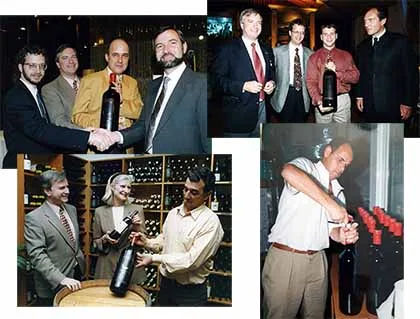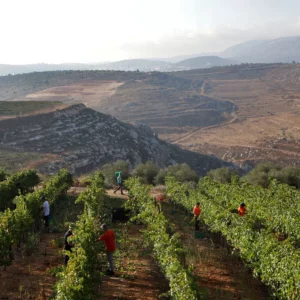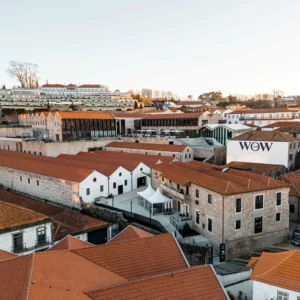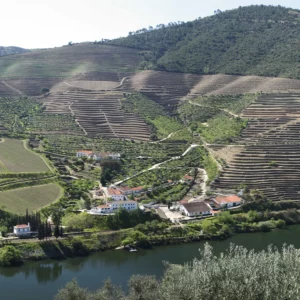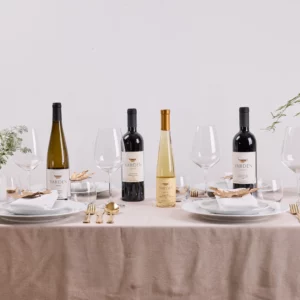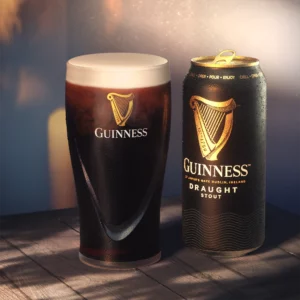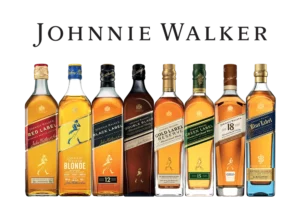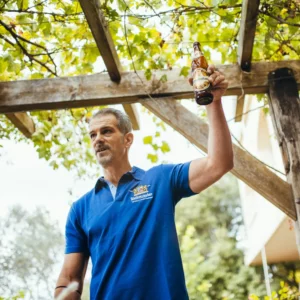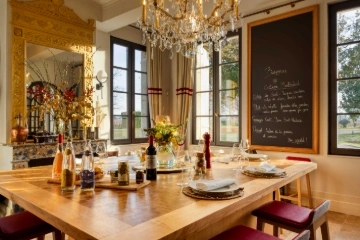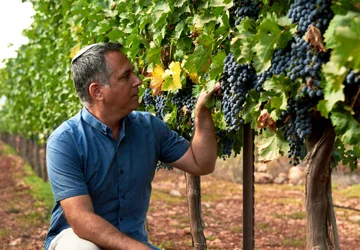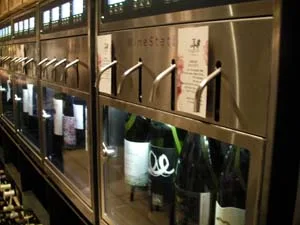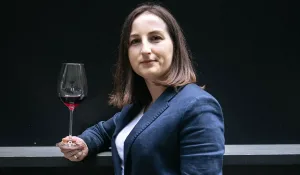Yarden Katzrin 2016 has just been launched, thirty years after the first Katzrin was made in 1990. To put this in perspective, thirty years ago Israeli wine was in a different place entirely…and so was I! In 1986, when I became wine manager for Bass Charrington’s hotel division, I started working with Israeli wines (Yarden, Gamla and Golan) for the first time. When I made Aliyah to Israel, I started working for Israeli wineries in 1990. When I arrived, the situation was as follows. The leading Israeli red wines were Yarden Cabernet Sauvignon 1985, Ha’yayin Shel Segal 1988 (Segal’s Wine), and Carmel Rothschild Cabernet Sauvignon 1985. People still talked about the Carmel Special Reserves of 1976 and 1979, and the award winning Yarden Cabernet Sauvignon 1984, and at that stage the first Margalit wine, the 1989, had been made but we are talking about individual barrels, so though appreciated, the wine was barely known. In those days I used to think the best red wines were made by Yarden, followed by Segal and the best white wines were also made by Yarden, followed by Tishbi (then Baron.)
The largest wineries were Carmel Mizrahi, Eliaz and Efrat. WEST-Stock (Monfort etc) had just gone bankrupt. Including the monasteries and the ‘Jerusalem wineries,’ there were just twelve wineries in total. The harvest was half as much as today and in those days, Carmel Mizrahi had 75% of the market. Selected Emerald Riesling was the largest selling wine and whites outsold reds.
Golan Heights Winery came onto the Israeli wine scene like a comet and through example changed the Israeli wine forever. The idea of making wine in the vineyards, planting at high elevations, introducing advanced technology in the winery, prestige wine marketing, organizing innovative winery events for PR, were all was done for the first time under their watch.
In 1990, the winery decided to make Israel’s first super deluxe wine. The grapes were harvested and the wine was made by Jim Klein, who was the last winemaker of the winery before Victor Schoenfeld. Victor became Head Winemaker in 1992 and he made the blend, mainly Cabernet Sauvignon, balanced by Merlot. As a result of two winemakers being involved, Peter Stern, the Californian wine consultant who was an important figure to the winery in those days, had the honor of signing the back label.
Segev Yerovam was CEO of the winery at that time. Today he is scarcely known by the younger generation, but those who knew him, remember him as a legendary CEO and the visionary brain behind many of the winery’s ground breaking initiatives. He insisted on calling the wine ‘Katzrin’, named after the small town in the central Golan, where the winery is situated. I was working for the winery at this time and I was one of those against this name. I thought it sounded harsh and for me, Katzrin did not conjure up something stylish and of high quality. However as usual, Segev was right. His instincts were always infallible.
Yarden Katzrin 1990 was launched in 1994. The wine was immediately priced up, and for the first time a wine was made to target the aspirational private collector, rather than the more regular channels of hotels, restaurants and wine shops. Buyers were rationed and the next wine was not made for another three years, so the hype and scarcity made for excellent marketing.
Yarden Katzrin became Israel’s first ‘Icon’ wine. In American parlance this is a wine costing more than US$100…..and Yarden Katzrin became the first Israeli 100 dollar wine. It used to be the height of showing off for a private collector to throw open his cellar and show how many Katzrin bottles he had. This was done by buying his allowance under his own name and then sending in his ‘sisters, cousins and aunts’ (with apologies to Gilbert and Sullivan), or anyone else that could help him increase his stash.
I have a few Katzrin memories of my own. 1994 was the year the Golan Heights Winery hosted the great Robert Mondavi at the winery. I had the honor and thrill of having dinner with him at Tapuach Hazahav Restaurant. His wife Margrit, an artist, drew an improvised drawing on a paper napkin, which I still have. A few years later I was invited to lunch at Mondavi Winery in Napa Valley with Peter Stern. We sat with Michael Mondavi, the elder son and the wine we drank was Yarden Katzrin 1990! For me to drink an Israeli wine with Mondavi at their winery, was a kind of coming of age.
Then, I remember a charity auction, one of the first in Israel, compered by television and wine personality Meni Peer at the Tel Aviv Hilton. The most expensive wine was a double magnum, three liter bottle of Yarden Katzrin 1993 which was purchased by the wine maker & educator, Barry Saslove. I don’t remember the price, but it was the most expensive Israeli wine ever sold at the time.
When I was export manager of the Golan Heights Winery, I was rationed to 10 cases of Yarden Katzrin for the whole of the world. Nothing creates interest like hunger. Instead of selling bottle by bottle, or case by case, I decided to go for broke. I visited one restaurant, Charlie Trotter’s in Chicago. At the time, this was one of the most famous restaurants in America. Charlie Trotter was an amazing, role model chef and his wine knowledge, a 26,000 bottle investment cellar and the attention given to high standards of wine service were unsurpassed. The second to none image for wine there, was created by the great Larry Stone MS, one of the world’s most famous sommeliers and a wine hero of mine. I went to the restaurant nervously carrying a bottle of the Katzrin and was graciously received by the sommelier Belinda Chang, who is also a very well-known sommelier. She received me in a formal way. There was no invitation to sit or time for small talk. So, we stayed standing for the few minutes she had spare. She must have had so many reps visiting her. I was in the middle of my spiel, when Charlie Trotter himself, put his head round the door and said: “we will take it all!” The story illustrates this wine’s part in creating a prestige category for Israel.
Another memory of Katzrin in the late 1990’s was the Golan Vintage Culinary & Wine Festival. At the Gala Dinner, Yarden Katzrin was served. I was with the famous French sommelier Philippe Bourguignon as he chipped away the wax from the top of the bottles so he could open them. We opened and tasted sixteen large format bottles. It certainly was extremely rare, even unique, for so many large bottles of Katzrin to be opened at one time.
After I left the winery, my interactions with the wine became rarer. I tasted the Yarden Katzrin 1990 at a recent Seder Night. It represents the year I came into the Israeli wine trade, so it had some emotional value for me. Unfortunately, the wine was passed its best. However, I was privileged to taste the Yarden Katzrin 1993 in 2018. It was a revelation, still youthful and everything in place….after twenty five years! This reminded me again, that Israeli wine lasts longer that we have been led to believe and that Yarden wines are the best bet for long term cellaring, (along with Margalit in my opinion.)
Over the years, Yarden Katzrin has become less scarce. It is produced more often. Most times, the wine has tended to be basically a Cabernet Sauvignon, balanced with a little Merlot. The Golan Heights Winery are the kings of Cabernet. The Yarden Cabernet Sauvignon, Gamla Cabernet Sauvignon and Mount Hermon Red (a blend including Cabernet) are each market leaders at different price points. In some years (1996, 2000, 2003) a smidgeon of Cabernet Franc was added. More recently (in 2012 and 2014), a tiny amount of Petit Verdot and Malbec was added for the first time.
Now the 2016 has been released, virtually, because of Covid 19. It is only the thirteenth Yarden Katzrin to be produced. It is a groundbreaking wine. Firstly, it is thirty years since the first Katzrin was made. Secondly, it is the twenty-nine years since Victor joined the winery. Since then he has become an institution.
Finally, it is the first Katzrin made from all five Bordeaux varieties. It is a blend 75% Cabernet Sauvignon, 9% Malbec, 9% Merlot, 5% Petit Verdot and 2% Cabernet Franc. This is the lowest percentage of Cabernet Sauvignon ever, in a Katzrin wine. Fortunately, it adds up to 100. Once in my time, the grape variety percentages on the back label added up to more than one hundred. The marketing people were prepared to die a death, but no-one noticed and the wine was lauded nonetheless! In theory the five traditional varieties of Bordeaux make a perfect blend. The Cabernet Sauvignon provides structure, the Malbec fruit, the Merlot a soft texture, the Cabernet Franc aroma and the Petit Verdot color and tannin.
How the winemaker makes a blend, is to isolate the finest plots for each variety. The Golan Heights Winery makes more than 400 boutique single vineyard, or rather single plot wines. These are aged and then tasted again, so the winemaker and his team are able to isolate the best of the best for what is the ultimate expression from the winery. In this case the different varieties are aged separately in small French oak barrels for 18 months. After final selection, the blend is returned to oak barrels for a further 6 months. The vintage of 2016 was also a good year and relatively stable, especially after the calamitous 2015. In fact, it was the shortest harvest by the winery in 22 years.
Today, the Yarden Katzrin 2016 costs 490 shekels. The other famous Israeli prestige wines like Castel Grand Vin, Margalit Enigma and Tzora Misty Hills all cost under 300 shekels. Does the wine justify the price and the answer is never, but I suppose if you have to ask the price, then it is not the wine for you. The 1848 Winery Grand Reserve, Alexander The Great Grand Reserve, Dalton Matatia, Margalit Special Reserve and Clos de Gat Sycra Cabernet Sauvignon are examples of wines that break the 300 shekel barrier….and they all get snapped up. So, prestige, rarity and exclusivity are traits of a wine that need to be taken into account, not just quality.
When the Bordeaux classification was made in 1855, a ranking was made listing the best wineries on the Left Bank of Bordeaux (luckily it is called the Left Bank, rather than West Bank!). Chateau Lafite was selected as the first of the firsts. Astonishingly, this same ranking still carries weight today, yet the ranking was primarily made on price. By this criteria, Yarden Katzrin is also a statement, with added value and status. It is a target for collectors and it has maintained its mythical image that it had back in 1994.
Over all this time, the label has barely changed. It is still in a tall, handsome bottle, with a stylish narrow, black label. Look at the best wines over the years and the labels barely change. Castel, Margalit, Clos de Gat and Yarden have the same look they always did. Compare this, for instance, to Carmel and Barkan over the same period, where each new manager feels compelled to make their own label changes as if to signify they have been there!
Funnily enough, the Golan Heights Winery has launched this wine without giving journalists an opportunity to taste it. So, I will do something I have never done, which is to reproduce Victor’s tasting note: “The 2016 Yarden Katzrin hints at its richness with the first whiff of its aroma. This special wine expresses attractive characters of ripe cherries, blackberries and plums, intermingling with pleasing notes of orange peel and chocolate, earth and herb, flowers and spice. Full bodied, this complex wine displays concentrated flavors and a very long finish.” Normally a wine critic writes about a wine they have tasted. In this instance, I can only say with all the authority I can muster: “Well, it sounds like a good wine!’ As for taste, you will have to take Victor’s word for it!
Anyway, I am a story teller more than a critic, and after thirty years since its first launch, it is worth telling the story of what became Israel’s first cult wine. The production of Yarden Katzrin 1990 remains a milestone in the evolution of Israeli wine and the Yarden Katzrin 2016 reminds us that the quality, consistency and professionalism is ongoing.
Wine trade veteran Adam Montefiore has contributed to the advance of Israeli wines for nearly 35 years. He is referred to as ‘the English voice of Israeli wine’. He is the wine writer of the Jerusalem Post. www.adammontefiore.com
Photo Yarden Katzrin 2016: Haggit Goren


